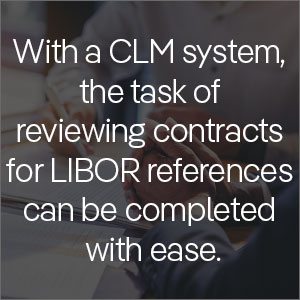There is no doubt that the COVID-19 crisis has had a measurable economic impact globally, with many financial services being affected adversely. Similarly, the moving away from the LIBOR benchmark interest rate and LIBOR transition — this upcoming year — is leading to a metamorphosis in the markets.
In a previous blog post, we discussed how changes to the London Interbank Offered Rate (LIBOR) are scheduled to take effect at the end of 2021. After this year, Interbank Offered Rates (IBOR), including the London Interbank Offered Rate (LIBOR), will no longer be published. The U.K.’s Financial Conduct Authority (FCA) announced, in July 2017, that after 2021, it would no longer compel panel banks to make submissions enabling the calculation of LIBOR. The FCA said that there will be new reference rates for pricing financial assets instead.
This is a shift that will likely affect more than the US $400 trillion worth of financial arrangements globally — from loans, insurance contracts, leases, and mortgages. It will also lead to fundamental changes in current business models and agreements.
To be ready for this transition, financial regulators around the world have been busy outlining and preparing procedures. Organizations have followed suit, anticipating how this shift is going to affect their agreements in the near future. With the switch approaching soon, they need to thoroughly review contracts and related documents for references to these pertinent rates. After all, a smooth LIBOR transition is key to ensuring business continuity.
LIBOR Transition Updates
On April 6, 2021, New York Governor Andrew Cuomo ratified the Senate Bill 297B-Assembly Bill 164B — or the New York LIBOR Bill. This as the U.S. and global financial institutions are overwhelmed with handling the USD LIBOR’s changes, which are currently scheduled for the summer of 2023.
The goal of the New York LIBOR Bill, of course, is to help ease the LIBOR transition by creating statutory remedies for tough legacy contracts (These are long-term financial agreements that reference USD LIBOR as a benchmark interest rate). The bill was designed to fill these interest rate gaps by transitioning all difficult legacy contracts, governed by New York State law, according to a “recommended benchmark replacement” rate.
This replacement rate, which is based on the Secured Overnight Finance Rate (SOFR), will include relevant adjustments and all other changes recommended by the Federal Reserve Board or the Federal Reserve Bank of New York.
In essence, the New York LIBOR Bill creates a safe space for parties with tough legacy contracts — those stemming from the liability around switching to SOFR. Even though the legislation provides a legal fallback for legacy contracts, it neither overrides existing fallbacks nor prevents parties from agreeing to other fallback rates.
The even better news is that there are appropriate steps organizations can take now to deal with the ever-fluctuating market. Here are three of them:
Preparation for the LIBOR Transition
Even without knowing the full outcome, your legal team and company should aim to prepare for the LIBOR transition today. Regulators have insisted that there will be no delay as a result of the COVID-19 pandemic. Therefore, companies must act now to prevent exposure to the many risks and regulatory and litigation issues. This means assessing what areas of the business will be impacted potentially and whether existing agreements need to be addressed or amended altogether.
What Can You Do Today?
- Continue to monitor LIBOR updates and seek other information, so you can continue to be informed and prepared for what happens next
- Identify all contracts and related documents that reference LIBOR term rates, and consolidate them in a central repository for easier access and review
- Consider leveraging an AI-powered contract lifecycle management (CLM) solution, to automate and speed up the process of finding LIBOR references.
Using Contract Lifecycle Management Systems for Your Agreements
As stated above, trillions of dollars of existing financial contracts, which reference LIBOR and extend beyond 2021, will need to be addressed, reviewed, and amended significantly. Legal teams will have to go through hundreds — if not thousands — of agreements to find these particular references. And this will take copious amounts of time and effort.
With a CLM system, however, the task of reviewing contracts for LIBOR references can be completed with ease — and in record time. Such contract management software highlights clauses referencing LIBOR, reducing risk and compliance issues before it is too late. It helps companies meet all legal requirements concerning governance and transparency, not to mention eliminates the manual contract review process.
More specifically, a contract management system (CMS) like the above conducts an extensive review of agreements in the repository. Using optimal character recognition (OCR) technology and artificial intelligence, it discovers all relevant terms and numbers in mere seconds. This alleviates the stress associated with LIBOR, saves companies’ time and money, and allows legal teams to focus on higher-level, strategic tasks.
Ready for the Transition from LIBOR?
Indeed, the transition from LIBOR will be long and tedious for the majority of organizations. It will be rather difficult, too, potentially taking a huge toll on legal teams. This will only be worsened by the uncertainty surrounding COVID-19 and ongoing changes in the global economy.
But by making a plan to manage contractual issues more efficiently and effectively — through the adoption and implementation of the latest legal technology — they will be fully prepared for the LIBOR switch by the end of 2021.
To find out more about choosing the right legal automation system, check out our recent white paper, “How to Choose a Contract Management Solution.”
Author:

Edward Chick
Connect with us on Linkedin











